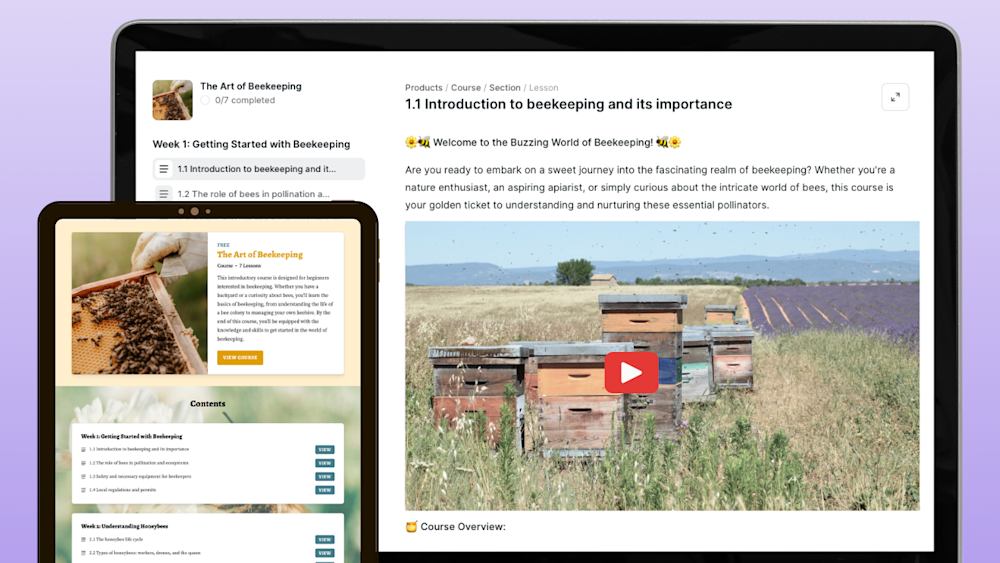You’re looking at your notebooks of course ideas, frustrated.
You know you could create an awesome online course, but none of your course ideas have screamed “profitable” and “in-demand”.
Scouring the internet wasn’t all that fruitful, nor was surveying your email subscribers.
But you’re not out of options yet -- you could go to Facebook groups for ideas.
Facebook Groups can be a goldmine of ideas if you know where to look and what to look for.
True, Facebook groups aren’t the most common way to identify course ideas. Despite that, they’re an effective, affordable, and accessible tool for creators.
In just four steps, you can get started sourcing Facebook groups for course ideas -- read on to find out how.
How to use Facebook groups to find online course ideas
Method #1: Participate in other’s groups
Want to conduct customer research with a broad group of people?
Then join other businesses’ groups.
There are a couple of methods you could use to find groups worth joining. The first is to type in “Facebook groups for [your field]” or a variant into a search engine.
You could also search for groups in the Facebook search box, use the “Discover” groups tab, or ask friends to invite you to secret groups.
Next, join groups relevant to your brand and audience -- 10 to 15 should be enough. If you can, join a mix of large and small groups.
Larger groups have more members, which can mean more posts and members to observe. However, large groups may also have more unengaged or insincere members.
Smaller groups can have more engaged audiences but a lower reach since they have fewer members.
In each group you join, post or comment two to three times a week for several weeks. By doing so, you’ll earn a reputation as an active and genuine participant.
Your comment strategy will take time to yield noticeable results. But with a little patience, it can increase brand awareness and grow your group’s member base.
But just what should you post?
Answering other members’ comments is always a good approach, as is sharing helpful content from other brands.
You could share your content from time to time, although you should keep it to a minimum so you won’t violate group rules or come across as spammy.
71% of consumers prefer to discover product products on their own through online searches and social media, among other channels.
In other words, you may have better luck by sharing more interesting and less promotional content in your groups.
But don’t stop there — take time to personally speak with members one-on-one or in group discussions.
70% of consumers have said they feel more connected to a brand when a company’s CEO is active on social media. 65% also said it makes it feel as if there are real people behind the brand.
Even if you’re not a CEO, chances are customers will still appreciate having a member of a company talking to them.
To learn more from members, ask questions about their pain points and goals. Asking for product and brand recommendations can be helpful, too.
Reading through past discussions can uncover heaps of helpful information, as well.
Let’s say I wanted to design a course about artisan bread baking.
I noticed several course topics by browsing this artisan bread baking group’s discussions for less than one minute.
Aside from identifying course topics, past conversations can reveal members’ product preferences and desires, too.
In the On30 Railroading group, for example, a member talked about approaching a manufacturer to make a train model they wanted.
Posts like this are great opportunities to ask further questions about what members are looking for in a product.
With just a few hours of effort, you could also create a product prototype, like a mini-course or digital download, and give it away to the group for free (we’ll cover product prototypes more in a minute).
Their reactions could uncover more subtle yet powerful information about their preferences, too, and could give you inspiration for creating your paid product.
Bottom line:
Existing Facebook groups can give you access to a diverse group of people to learn from as you’re collecting course ideas.
Method #2: Get to know your audience
Only 20% of brands make a positive impact on consumers’ lives, one report found.
To be among that 20%, talk with your group members to see what products and messages are relevant to them.
Comments on posts from both your own brand and third-party sources are a good way to get the pulse on your customers’ thoughts and desires, too.
Consider Rhone’s example. Rhone learned by observing their Facebook group that their customers wanted a durable casual shirt.
They then asked their members what Rhone’s first durable casual shirt should look like. Rhone went on to sell several thousand shirts in just weeks.
Bimbo also learned about their customers’ preferences by listening to online conversations.
Specifically, they learned that Mexican consumers wanted a limited-edition flavor of their Gansito cake that was only available in the United States.
After releasing it in Mexico, it sold our four weeks earlier than expected.
Whatever content you share in your group, make sure your community is a welcoming and valuable place for your members.
39% of consumers have said they feel more connected to a brand when they create strong online communities.
Another 55% said they feel that connection when brands respond to or like something another consumer said.
Besides creating a welcoming and educational space, offer an incentive for participation in your group.
59% of American consumers have said that personalized discounts and gift cards can help maintain their loyalty.
To put that into practice, you could perhaps give the first 25 commenters on a post an exclusive, limited-time discount.
Alternatively, you could give the most active members a gift card at the end of the year as a “thank you” for their participation.
If discounts aren’t your thing, you could also give away free digital downloads or offer one-on-one consultations for select members, instead.
Basically:
To learn more about your customers’ product preferences, think beyond surveys. Share relevant content within your group, respond to questions, and measure your members’ reactions.
And, as your group grows, follow it up with our next method.
Method #3: Examine members’ profiles posting history
To better understand who your target audience is, supplement observing what they say in group forums by checking out their Facebook profiles, too.
Just a few minutes of scrolling through a member’s Facebook profile can reveal information about their struggles, product and brand preferences, previous purchases, and more.
57% of consumers have said social media affects their buying habits, with 19% of American shoppers saying they purchased something because an influencer or blogger recommended it.
By examining members’ profiles, you could see if their buying habits are affected by Facebook ads, organic posts, affiliate and referral links from friends, or influencers.
You could then tweak your marketing strategy to appeal to your customers, such as by using Facebook ads or tapping into influencer outreach.
Likewise, studying their past purchases, reviews, and brands they follow can reveal what products they liked or disliked. It can also hint at which aspects of competitors’ products you could emulate or avoid when designing your course.
With this information in hand, you could create buyer personas, or ideal customers based on your followers’ most common traits and habits.
Here’s an example of one from Smartbug:
With a buyer persona in hand, you can use it as a guide as you come up with course content and marketing campaigns.
You can also use “Audience Insights” to learn more about your audience members, such as their demographic information and Facebook usage.
The gist is:
Facebook groups can be chock-full of product ideas and inspiration, but members’ profiles can reveal more granular information.
And, ideally, between observing members both in your and others’ groups, you’ll have more than enough information on hand to proceed to the final step.
Method #4: Test your course ideas
After a few weeks of information collection, you’re ready to test your findings with a scaled-back version of your course.
Depending on your group’s size and level of engagement, you could follow Bark’s lead and create a VIP group where your most loyal and enthusiastic customers can evaluate your ideas.
Regardless of if you create a second VIP group or rely on your main group, you have a few ways to test your course idea.
One way to validate your product is by creating short three- to five-minute YouTube videos where you answer common group questions. You could also record a handful of lessons you want to include in your course.
If your videos receive many views, shares, and comments, you could then bundle them into an online course.
You could also pre-launch your online course and use your sales as an indicator of whether you should proceed with creating the course.
Foundr, for instance, pre-sold several online courses and created the courses that earned the most pre-sales first.
Lastly, you could release a short 30- to 45-minute version of your course. Then launch the course to your followers and see how it performs sales-wise.
Regardless of where and how you launch your prototype course, prioritize collecting feedback. You need it more than you might think.
But you don’t need it every week or all at once.
It’s better to slowly release high-quality modules based on customer evaluations than to rush-deliver a course your customers are less than ecstatic about.
In the words of digital product creator, Reuven Lerner: “It's easy to say, ‘I'll release this when it's good.’ or ‘I'm not sure if this course is really something people want to pay for.’ Well, find out by putting it out there!”
Involving customers in the process can be a win besides creating more in-demand content -- it can also grow sales.
One research study found that involving customers in the ideation and launch stages of a new product could increase its financial performance (i.e., sales).
But involving your customers at every stage of the product creation process may hurt your product and sales.
The same study found that including customers in the development stage could slow the time it takes to go to market. It could also negatively affect its financial performance.
For those reasons, limit feedback to the idea generation and product launch stages. You could also collect feedback after launching each version of your prototype, too.
Now, there’s a final benefit to slowly testing your online course: getting reviews.
Each customer’s buying journey is unique and complex. Nonetheless, chances are other customers’ reviews, and recommendations will affect their decisions.
Research has found that a product with five reviews is 270% more likely to be purchased than a product with no reviews.
Reviews can boost your sales whether you’re selling low- or high-priced products, too.
The conversion rate for low-priced products increased by 190%, according to recent research. Higher-priced products saw a 380% increase.
If you build your product sales page with Podia, you can add as many customer reviews and testimonial videos as you like. Using our simple two-step check out process may help your sales figures, as well.
See how easy Podia can make it to pre-sell and sell your online course by testing it yourself with a 30-day free trial.
Otherwise, just keep this in mind:
Receiving feedback is never easy, but you -- and your customers -- will be glad you did after you create a high-selling course.
Find profitable courses ideas in Facebook groups
With Facebook groups, you can say “hello” to a near-infinite supply of course ideas.
There are four methods of finding online course ideas with Facebook groups, including:
-
Participating in other brands’ groups and observing members’ discussions and comments
-
Creating your own Facebook group to both study and nurture your audience
-
Exploring your Facebook group members’ profiles to learn more about their product preferences
-
Creating a testable mini-course and collecting feedback from your Facebook group members
With a little patience, you should have no problem finding course ideas hidden within Facebook groups, and who knows, maybe you’ll even pick up your first dozen customers while you’re at it, too.



